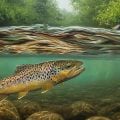Imitation or Presentation?
Have a question you want answered? Email it to us at ask@midcurrent.com.
Question: Which do you think is more important, imitation or presentation? I heard about this guy who uses only four or five attractor patterns for all his trout fishing, claiming that if the drift is good, the pattern doesn’t matter. What do you think? Will a well-presented Royal Wulff outfish a mediocre presentation of an exact imitation during a BWO hatch?
via email
Answer: For me, this question puts in specific terms what’s really a much larger question about the sport—Is fly fishing for trout more about mastering a complex set of skills or can you skip a few steps by finding a “magic bullet?” Here’s what our experts had to say.

photo by TJPainter
Bob Streb—head guide at Minturn Anglers in Minturn, Colorado: It’s all about the drift. Over the years of guiding, I have stopped changing flies so much and concentrate on presentation. One of the best ways I’ve come up with to explain the importance of your drift sounds something like this: I love cheeseburgers. You can serve me a cheeseburger on a napkin, paper plate, fine china, or just kindly hand me one. But if you put one on a skateboard and shove it across the floor, I’m going to hesitate, at best. Trout concentrate on positives; they don’t analyze or rationalize. No mend, no bend.
Frank Smethurst—Guide, reality TV star, and Bigfoot LARPer: I think that presentation is easily the more important of the two considerations, but as in all aspects of fishing, you can’t perpetually rely on any principle, method, or fly. I feel generally that an educated choice in skillfully presented attractors is best as a searching pattern, but that once even a mild hatch begins, transitioning then to more imitative flies will enhance the success. Through all of this, accuracy of cast and freedom of drift will ALWAYS account for the largest amount of success with trout.
Another important aspect of presentation would also be those times when the fly is to be animated, whether at the end of a drift or throughout the presentation. To me this is where the technique in creatively moving the fly is much more important than the streamer, crab, or bugger tied onto the end of the line. I see too many folks using a pretty repetitive 16-inch pull. And though this still catches plenty of fish, many are the times where something more akin to puppetry of the fly makes the larger and smarter fish come out of the woodwork. It is their job after all, once sold on the idea that something is both real and available, to convincingly go and eat it. Here is where blending strips of varying length and rod movement of varying types to get the properly compelling result is essential.
Great practice for learning greater technique in this area is fishing topwater flies like Mice. You can see when your efforts are delivering both more and less nuance to the fly’s movements, and then replicate these techniques for subsurface.
Tom Rosenbauer—host of the Orvis Fly-Fishing Podcast: Presentation for trout 80%, imitation 20%. For steelhead and most saltwater species, I imagine the presentation value would be closer to 90%.
Brian Grossenbacher—photographer and guide: Presentation, Presentation, Presentation! It doesn’t matter how good your fly looks in the box; if it doesn’t drift naturally on the water, you have a serious problem. I once read a story in Paul Arnold’s book Wisdom of the Guides about Al Troth. He was guiding a client on the Beaverhead, and they were sight-nymphing to a particularly large brown. After several casts with no luck, the client claimed they must not have the right pattern. Al encouraged the client to work on his drift because it was the presentation, not the fly, that was the problem. The client made several more casts without success and continued on about needing a new fly. Finally disgusted, Al bet the client $50 that he could catch the fish with a piece of his sock. The client agreed, so Al clipped down the fly to a bare hook and then walked to the bank, where he took off his waders and pulled a thread from his olive-green wool socks and wrapped it around the head of the hook like a thorax. You guessed it: he caught the brown on the first cast.
There are certainly exceptions to this, and ideally the best combination would be to have the right fly in conjunction with the right drift, but if I had to choose between the two, I would take presentation every time.
Jim Bartschi—president of Scott Fly Rod Company: Presentation trumps imitation, in general. For really selective or heavily pressured fish, you’ll need both imitation and presentation on your side, but the edge still goes to presentation. Oh, and presentation is a lot more than drag-free dry-fly drifts. I consider presentation to mean just that—the way the fly presents itself to the fish, whether it’s fished on the surface, down deep, drag-free, or with controlled drag. The food type, water conditions, and feeding behavior determine which presentation and which imitation to use.
Dave Kumlien—long-time Montana guide and current head of TU’s Aquatic Nuisance Species program: Years ago, I had the opportunity to meet Lee and Joan Wulff at Bob Jacklin’s Fly Shop in West Yellowstone, and I asked Lee this very question. He was adamant that presentation was the key, and he said he’d be willing to take ANY pattern I suggested and go out and catch trout. My 30+ years of fly fishing outfitting and guiding experience in southwest Montana would support Lee’s position, but as this question is about which is MORE important, I would add that there are some fishing situations where pattern is an important factor, too. For example, the challenge of hatch-based fishing encountered on waters like the Henry’s Fork, the Missouri, the Bighorn, or the Yellowstone Spring Creeks would indicate that pattern can be very important. I am mostly a moving-water fly fisher, and it is my belief that drag, the unnatural movement of my fly in relation to the current, causes more rejections of my offerings than any other factor. There’s nothing like a good, drag-free float to fool the fish, and I am sure Lee would say that if given a small Royal Wulff to fish during a BWO hatch, it would be fine with him!
Matt Supinski—owner of Gray Drake Outfitters in Newaygo, Michigan: It all boils down to science and biological ecosystem niches that the trout live in. It is a pure and factual evaluation. On extremely nutrient-rich alkaline waters, like spring creeks, and plankton-rich tailwaters, the biological drift of aquatic vertebrates and invertebrates (trout food) is extremely diverse. Along with the slower flows and greater prey inspection and capture times allowed to the fish, both imitation and presentation are extremely critical. A Royal Wulff won’t cut it when you’re fishing to extremely selective sippers eating still-born sulfur emergers in the film.
On extremely volatile, cascading freestone rivers, high in acidity and low in nutrients for the food chain, attractors can work anytime due to the shorter inspection times and limited opportunities for the trout to eat. Plus, the faster bubbling waters of cascading rapids and fast glacial rivers causes require quicker judgment, so the trout tend to be more stupid and careless.
Brant Oswald—Livingston, Montana-based guide and author: The carefully repressed academic in me loves this one. It sounds like coffee-shop talk for a group of freshman philosophy majors. Rationalism or empiricism? Free will or determinism? Nature or nurture? Ginger or Mary Ann? Posing the question in this way—which presumes that imitation and presentation are discrete processes, and that they are the only choices—reflects some flawed critical thinking, but it does provide a tool for thinking about the real nature of the sport.
For me, the question doesn’t make sense, since I find fly fishing to be defined by theblending of skills, not by any single skill or set of skills—including fly selection and presentation. Even in the reader’s question, notice how difficult it is to separate these concepts—if pattern doesn’t really matter, why does this guy he’s heard about need 4 or 5 patterns? Why not just one? And what “attractor” flies are we talking about? Where is the dividing line between an attractor and an imitative fly pattern? And when the fish does eat the fly, how do we determine what triggered the strike? Was it the design of the fly, the way it was presented, or something else we haven’t considered? Until we start doing more sophisticated research on fish brains and feeding behavior, the answers to these questions are just educated guesses.
As a guide who spends a lot of time on spring creeks and tailwaters, I see plenty of situations where pattern is important. When fish have a rich enough food supply to become selective feeders, then “matching the hatch” —to some degree—really does yield more strikes. But the most imitative fly pattern in the world won’t work if we neglect presentation skills. We still have to approach the fish, cast accurately, control line and leader to get a good drift, etc., etc. (And if you want to carry a fly box with only 4 or 5 patterns, pick fishing situations where pattern is not as critical.)
So…“will a well-presented Royal Wulff outfish a mediocre presentation of an exact imitation during a BWO hatch?” Who cares? Why would you want to waste your precious fishing time finding out? This is a little like deciding to play golf with one club and then asking, “Which would work better, a putter off the tee or a driver on the greens?” Why not fish a reasonable imitation of that BWO, using all of the presentation skills you can muster, before you try to limit yourself too much?
Fly fishing is complex enough that we can choose to eliminate a few of the variables involved and still have fun playing the game. And some find added challenge or interest with self-imposed restrictions—dry flies only, or upstream presentations only to a rising or visible fish, only with flies I’ve tied myself, etc. This is fine, if these limitations make fishing more fun or fulfilling, but it can be easy to lose touch with the reasons we fish. I remember sharing a week at a saltwater lodge with an angler who decided he was going to catch a bonefish on a dry fly, a new revolutionary pattern of his own design. Despite the protests of his Belizean guides, he fished all week with his dry fly, catching nothing while the rest of us enjoyed consistent fishing. On the last day, he claimed success—he finally caught one tiny fish of less than a pound. (His guide told me later the fish ate his dry fly after it got waterlogged and sank.) Did he enjoy his week of fishing? I hope so, but I wonder.
After four decades of trying to learn all I can about fly fishing, I find the complexity—observing and trying to manage all of the variables of water and fish and bugs and weather—to be what keeps me fascinated. So I’ll keep on thinking that imitation and presentation are both important, and that neglecting one for the other makes fishing a lot less fun.
Steve Hemkens—divisional merchandising manager of Orvis Rod & Tackle: A good fisherman with great presentation can sometimes force-feed a selectively feeding fish with some nonsensical pattern that only vaguely matches the size and profile of the insect that is coming off. But given the choice between an impressionistic pattern to a selectively feeding fish or the most exact imitation possible, I would kill to have Rene Harrop’s fly box…especially on rivers like the Missouri, Bighorn, Henry’s Fork, West Branch of the Delaware, Battenkill, etc. where all elements come into play—leader length, tippet length, tippet diameter, presentation, fly selection. There are plenty of put-and-take rivers and more freestone streams where trout have to be opportunistic feeders to stay alive, but on nutrient-rich spring creeks, both presentation and imitation are mission critical.
Carl McNeil—Guide, casting instructor, and filmmaker: The short answers is yes…with a few caveats.
One of the greatest myths in fly-fishing dogma is that trout are selective feeders. They are not. Trout by their very nature are required to be opportunistic in their feeding approach.
Trout have to feed when food is available and make the most of what can be fairly short-lived and sporadic appearances of food. This behavior is often mistaken for selectivity, when in fact all that the fish is doing is making the absolute most of a given feeding opportunity—even in compound hatches of multiple species. When the Sushi train cranks up, you grab as much as you can in the shortest possible time, and when the Salmon Don is all gone, you start on something else.
A fly only need be an approximate facsimile of the natural and fit within the bandwidth of any given hatch in order to be effective. At the risk of over simplifying, it (almost) goes without saying that during a BWO hatch (or any hatch for that matter), a trout is not specifically looking for a fly that we may care to call a Blue-Winged Olive, nor is it looking for anything that we might describe as a Baetis of any description.
What it is keyed in on is the image of a certain food source, or to borrow a term from my mate Bob Wyatt, a certain “prey image.” Birders have this concept summed up beautifully in what they refer to as GISS—General Impression, Size, and Shape—and fly selection is no different. Bob’s written much about this subject and is well worth a read.
Your fly needs to be the correct size, present the good silhouette, and ride in the water at the correct attitude, and you’ll almost be cookin’—almost.
You’ll also need to present that fly in a manner that mimics the natural, usually drag-free. And this is where many presentations fall short of a good imitation. I’m a died-in-the-wool presentationist, and for me the term ‘presentation” describes a much more wholistic approach than just making a good drag-free cast. Presentation takes into account all the aforementioned variables: size, silhouette, attitude on the water, and finally, the cast.
To my mind imitation is a very one dimensional approach—perhaps easier to get your head around, but not nearly as effective as having all the bases covered and tipping the odds in your favor. I’m a firm believer that far too many anglers spend far too much time with their heads buried in their fly box and not enough time in observation or practice on the casting range.
Trout literally have a brain the size of a pea; it’s what’s termed a “simple” brain and is, in fact, a fairly simple four-lobed predatory organ. Most of this organ is dedicated to the control and processing of physical input. Vision, olfactory, lateral input, swimming, and balance take up the vast majority of processing power. It does not physically have the wherewithal to cope with any sort of higher cognitive function.
As much as we’d like to think that trout are wily, intelligent creatures, they are not. I don’t wish to belittle my favorite creature in any way, but they’re just not cable of much that common angling literature has given them credit for over the years. They are however, highly evolved, almost perfectly formed creatures, superbly engineered for mastery of their fluid home—and about the most beautiful critter you’re likely to clap eyes on.
In short, they don’t get to make reasoned decisions about what to eat, and there’s no evolutionary requirement for them to do so. For the life of me, I can’t recall any freshwater invertebrate that stings, is poisonous or could inflict any mortal harm on a feeding fish. Hell, we all know That Trout, and particularly rainbows and cutts will take just about anything from a cigarette butt to a piece of indicator yarn.
Fact is, there are literally hundreds of thousands of fly patterns out there—many, many times more than there are actual species. And they’ve all worked for someone at some time. This fact alone is pretty compelling evidence of the importance of general impression over specific imitation. In the front plate of G.E.M Skues classicThe way of a Trout with the Fly, he shows ten variations on the Blue Dun, a wonderful demonstration of pattern variance. The trout don’t care.
Two of the most successful fly patterns the world over would have to be the ubiquitous Hare’s Ear and Sawyers Pheasant Tail Nymph, and while Frank Sawyer designed his fly as a fairly specific imitation, both flies are super effective because they so effectively imitate just about everything in the water column.
So, would I tie on a Royal Wulff during a BWO hatch? If it was a reasonable match in terms of size, shape, and silhouette the answer would be yes. Although a high-floating dry would not be my first choice. I’d first reach for the scissors and snip the bottom off the hackle in order to get it to ride right down in the surface film. During a hatch an emerger is just about always effective than a high-floating dry. I’d then call it “My BWO” pattern just to keep the fly tiers and imitationists happy.
But hey, you tie on what ever gives you confidence: that’s half the trick.











